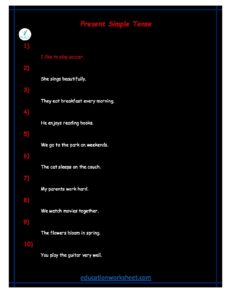how to converting Present Simple Tense negative sentences to interrogative form
how to converting Present Simple Tense negative sentences to interrogative form
Converting present simple tense negative sentences to interrogative form is a fundamental aspect of English grammar that allows us to ask questions about actions, events, or situations in the present. This transformation involves changing the sentence structure and sometimes using auxiliary verbs to create questions. In this comprehensive guide, we will delve into the intricacies of this conversion, providing a step-by-step explanation and numerous examples to help you grasp this concept thoroughly.
I. Understanding Present Simple Tense

Before we dive into converting negative sentences to interrogative form, let’s ensure we have a solid understanding of the present simple tense.
The present simple tense is used to describe habitual actions, general truths, scheduled events, and states of being in the present. It is formed by using the base form of the verb (the verb without “to”) for most subjects. However, when dealing with the third person singular (he, she, it), we add an “s” or “es” to the base form of the verb.
Here are some examples of sentences in the present simple tense:
- She plays the piano.
- They live in New York.
- It rains often in this region.
- I work as a teacher.
II. Converting Negative Sentences to Interrogative Form

To convert a negative sentence in the present simple tense to an interrogative sentence, follow these steps:
Step 1: Identify the Negative Sentence: Begin by identifying a sentence in the present simple tense that is in the negative form. Negative sentences typically contain words like “not” or “don’t/doesn’t.”
Example negative sentences:
- She does not like coffee.
- They don’t study Spanish.
- He does not play football.
- I don’t work on weekends.
how to converting Present Simple Tense negative sentences to interrogative form
Step 2: Rearrange the Words: To convert a negative sentence into an interrogative one, we need to change the word order. In English, interrogative sentences often start with an auxiliary verb or a question word (who, what, when, where, why, how).
Step 3: Add the Appropriate Auxiliary Verb: Depending on the subject and verb tense, you may need to add an auxiliary verb to the beginning of the sentence. For present simple tense questions, we often use the auxiliary verbs “do” or “does.”
Step 4: Add the Subject: Place the subject of the original sentence after the auxiliary verb.
Step 5: Complete the Question: Finally, add the main verb in its base form (without “to”) after the subject.
III. Examples: Now, let’s look at examples of converting negative sentences to interrogative form in the present simple tense.
how to converting Present Simple Tense negative sentences to interrogative form
Original Negative Sentences:
- She does not like coffee.
- They don’t study Spanish.
- He does not play football.
- I don’t work on weekends.
how to converting Present Simple Tense negative sentences to interrogative form
Converted Interrogative Sentences:
- Does she like coffee?
- Do they study Spanish?
- Does he play football?
- Do I work on weekends?
how to converting Present Simple Tense negative sentences to interrogative form
IV. Rules and Exceptions: While the conversion process seems straightforward, there are some rules and exceptions to consider:
1. Third-Person Singular (he, she, it):
- In the present simple tense, when forming questions for third-person singular subjects, use “does” as the auxiliary verb.
- For other subjects (I, you, we, they), use “do.”
Example:
- She plays the guitar. (Positive)
- Does she play the guitar? (Interrogative)
2. Questions with Question Words:
- When forming questions with question words (who, what, when, where, why, how), start the sentence with the question word, followed by the auxiliary verb (do/does), the subject, and the base form of the main verb.
Example:
- He eats pizza. (Positive)
- What does he eat? (Interrogative)
3. Yes/No Questions:
- These questions typically have a simple structure: auxiliary verb + subject + main verb.
- Use “do” or “does” based on the subject as the auxiliary verb.
Examples:
- Do you like ice cream?
- Does she swim in the lake?
V. Practice Exercises: Let’s practice converting negative sentences into interrogative ones with the following exercises:
Exercise 1: Convert the following negative sentences into interrogative sentences.
- They do not watch TV.
- She does not speak French.
- He does not eat fish.
- I don’t like spicy food.
- The cat doesn’t chase mice.
how to converting Present Simple Tense negative sentences to interrogative form
Exercise 2: Create your own negative sentences in the present simple tense and then convert them into interrogative sentences following the steps outlined earlier.
how to converting Present Simple Tense negative sentences to interrogative form
VI. Conclusion: Converting present simple tense negative sentences to interrogative form is an essential skill for effective communication in English. By following the steps provided in this guide, you can confidently transform negative statements into questions, allowing you to seek information, clarify doubts, and engage in meaningful conversations. Practice is key to mastering this skill, so be sure to apply what you’ve learned through exercises and real-life conversations to reinforce your understanding of this grammar concept.
how to converting Present Simple Tense negative sentences to interrogative form


